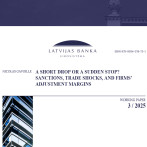Positive trends in retail trade continue
The retail trade turnover, according to seasonally adjusted data at constant prices, in December rose by 0.7% month-on- month. Year-on-year, the growth rate has also remained high at 12.5%. Such positive developments at the end of the year reinforced retail growth already observed in the second half of the year, and, compared to 2011, the indicator has reached 9.7%.
Such positive results were not unexpected. The Latvian retail trade confidence indicator published by the European Commission improved substantially in December, rising by 2.5 points. The same applies to the Latvian consumer confidence indicator: it increased by 3.9 points. Month-on-month, it is considered a significant improvement.
Moreover, in the second half of the year, the purchasing power of households continued to grow, as a result of growing salaries and the relatively low inflation level. The effect of postponed consumption also played a role: households purchased goods whose purchase had been postponed for the future. Retail growth is also stimulated by low interest rates on deposits and loans.
Parallel to developments in Latvia, the consumer and retail trade confidence indicators rose substantially also in our main trading partners (Lithuania and Estonia). Given that the demand in these countries contributed the greatest share to the growth of Latvian external demand earlier as well, this promoted rapid export growth in Latvia. The increase in the income of export businesses allows them to raise their employees’ income and consumption, thereby fostering retail trade increase in Latvia.
The positive results grow in significance when we consider that some factors could have had a negative effect on retail trade. First, the very high heating bills cut the income at the disposal of households, limiting their net worth. And, since December was cold, people could have sensed that in January they would have to pay the high heating bills for December and thus spend less. Yet data do not point at any slowdown in consumption.
Second, the balance on the amount of consumer loans granted to households continues to shrink, which does not promote consumption. Here it must be taken into account that lending statistics does not include the loans on offer by other, non-monetary-and-financial institutions (non-MFIs), which people tend to use more for consumption or to cover some payment.
Although the data on Estonian retail turnover in December are not yet available (they will be published tomorrow), the currently available data point to the Latvian average retail turnover growth as substantially higher in Latvia than in Estonia or Lithuania in 2012. This is supported by the fact that from January to December the highest rate in the improvement of consumer confidence was observed in Latvia. Moreover, as Nerijus Mičulis, the chief accountant of "Swedbank" has pointed out that Latvians use their income for consumption whereas Lithuanians direct a greater share of their income to accruals.
In predicting retail dynamics in the Baltic countries in the near future, I would like to point out the amendments to the laws of each of these countries that may have a positive effect on consumption and retail trade. The personal income tax cut in Latvia as of the beginning of the year increases net salaries and may thus have a positive impact on consumption. In Lithuania, the rise in minimum wage may affect retail trade in a positive way, but it must be noted that some of the unofficial income could become official thus only minimally improving purchasing power of the population. In Estonia, retail trade may benefit from the 2013 state budget that is aimed at relieving the tax burden on the labour force.
Textual error
«… …»






